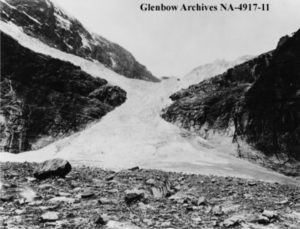
-Photo supplied through Wikimedia
A guardian angel has been looking down upon the town of Jasper for more than a century.
Mount Edith Cavell, a prominent part of the landscape for millions of years, was so-named in 1916 to honour the courageous British nurse who saved countless lives in Belgium during the First World War.
The famous nurse never set foot in Jasper, or even Canada for that matter, but people around the world felt a strong affection for Edith Louisa Cavell after she was executed by a German firing squad for treason. According to a display at the Jasper-Yellowhead Museum and Archives in Jasper, prior to her execution, she worked as matron of the Berkendael Surgical Institute in Brussels training nurses.
“After the German occupation of Belgium, she cared for wounded German troops and became involved with an underground group [facilitated through the hospital], which assisted British, French, and Belgian soldiers who were trapped behind enemy lines. The underground helped these soldiers escape to neutral Holland and rejoin their armies.”
Patriotism is not enough. I must have no hatred or bitterness towards anyone.” – Edith Cavell
Cavell claimed she was “a nurse who tried to do her duty” in that she offered treatment for both Allied and German soldiers during that time.
“She was considered a martyr,” said retired Canadian Forces Chaplain, David Prowse, who lives in Jasper. “Within a few months of her execution, the highest mountain you can see from the Jasper community was renamed in her memory.”
“I grew up here, so [Edith Cavell’s] been a big part of my life.”
The 49-year-old Cavell never denied her involvement in helping to smuggle Allied soldiers out of Belgium during the German occupation. She continued to promote the need to care for all even on the night before her execution.
Cavell’s famous words from her final night were, “Patriotism is not enough. I must have no hatred or bitterness towards anyone.”
Prowse said it was fitting to honour Cavell on this mountain since it features the scenic north-facing Angel Glacier that resembles an angel with outstretched wings.

-Photo courtesy of Glenbow Archives (Copied from PA-2828-17)
Mount Edith Cavell was previously known by fur traders, heading to the West Coast through the Athabasca Pass, as La Montagne de la Grande Traverse.
“Prime Minister Robert Borden directed the Geographic Board of Canada to select a peak,” reported Karen Byers, an archives clerk at the Jasper-based museum.
“The mountain stands out on the landscape and it is very striking,” added Byers. “It is a very popular attraction for visitors.”
Every year since, with the exception of 2020 due to the pandemic, a ceremony has been held on the first Sunday in August at the Jasper Anglican Church St. Mary and St. George to mark the date of Cavell’s arrest on August 5, 1915.
[Edith Cavell] was considered a martyr. Within a few months of her execution, the highest mountain you can see from the Jasper community was renamed in her memory.” – David Prowse, retired Canadian Forces Chaplain, Jasper.
Prowse, who has also served at this 14th-Century Gothic-styled church, presided over some of these commemorations during his tenure. Some services have also been held at the base of the mountain even featuring an organ carried to the site to accompany the choir.
On the centennial of Cavell’s death, Parks Canada organized special events to mark her arrest and the date of execution on October 12, 1915.
Prowse noted Cavell was also recognized throughout the world after her death, as well as in many Jasper locations including the Edith Cavell Memorial Tower which was added to the church in 1932. Memorials, plays, movies, books, and songs were also inspired by Cavell’s story.
Today, the nurse continues to be fondly regarded, and visitors from around the world pay tribute to her at the 3,363-metre mountain southwest of Jasper.
— Lorena Franchuk
